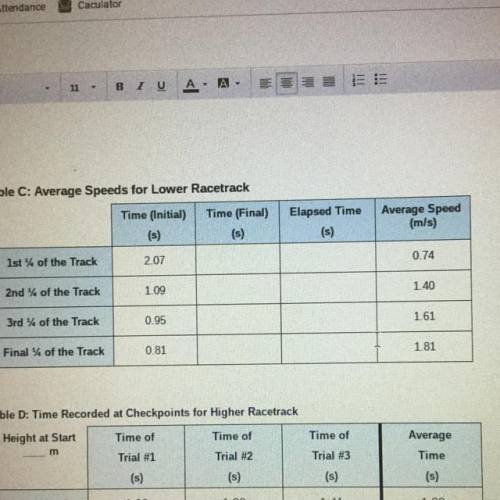Table C: Average Speeds for Lower Racetrack
Elapsed Time
Time (Initial)
(s)
Time...

Physics, 15.10.2020 23:01 shaeelynn3734
Table C: Average Speeds for Lower Racetrack
Elapsed Time
Time (Initial)
(s)
Time (Final)
(s)
Average Speed
(m/s)
0.74
1st of the Track
2.07
2nd %% of the Track
1.09
1.40
3rd of the Track
0.95
1.61
Final 44 of the Track
0.81
1.81


Answers: 3


Another question on Physics

Physics, 23.06.2019 00:20
An object with a mass of 1.5 kg changes its velocity from + 15 m/s to +22 m/s during a time interval of 3.5 seconds. what impulse was delivered to the objects?
Answers: 2

Physics, 23.06.2019 03:30
Explain how a step-down transformer makes electricity safe for use in homes
Answers: 2

Physics, 23.06.2019 08:30
Atension test was conducted on a specimen of aisi 1020 hot-rolled steel having an initialdiameter of 9.11 mm. representative test data are given in table1in the form of force and engineering strain. for strain the extensometer gage length was li= 50.8 mm. in addition, minimumdiameters were measuredmanually with a micrometer in the necked region at several points during the test. after fracture, thebroken halves were reassembled, and the following measurements were made: (1) marks originally 25.4 mm apart and on opposite sides of the necked regionwere 38.6 mm apart due to the lengthwise stretching in the specimen; (2) similar marks originally 50.8 mm apart were 70.9 mmapart; (3) the final minimum diameter in the necked region was 5.28 mma) determine the following material properties: elastic modulus, 0.2% offset yield strength, ultimate tensile strength, percent elongation, and percent reduction in area. b) assume that the test was interrupted upon reaching a strain u = 0.007, and the specimen unloaded to zero force. estimate the elastic strain recovered and the plastic strain remaining. also, what would the new length of the original 50.8 mm gage section. hint: might save time/effort to use excel, mathcad, matlab, etc. to solve part a)table1 data and analysis for a tension test on aisi 1020 hot-rolled steeltest dataforce (p, kn)1. 0.002. 6.673. 13.344. 19.135. 17.796. 17.217. 17.538. 17.449. 17.2110. 20.7711. 24.2512. 25.7113. 25.7514. 25.0415. 23.4916. 21.3517. 18.9018. 17.39engr. strain (ε)1. 02. 0.00053. 0.00104. 0.00155. 0.00236. 0.00317. 0.00508. 0.00709. 0.010010. 0.049011. 0.125012. 0.218013. 0.234014. 0.306015. 0.330016. 0.348017. 0.360018. 03660diameter (d, mm)1. 9.112. 9.113. 9.114. 9.115. 9.116. 9.117. 9.118. 9.119. 9.1110. 8.8911. 8.8912. 8.2613. 8.2614. 7.6215. 6.9916. 6.3517. 5.7218. 5.28
Answers: 2

Physics, 23.06.2019 09:30
Lake happy times contains 100 km3 of pure water. it is fed by a river at a rate of 50 km3/yr. at time zero, there is a factory on one shore of lake happy times that begins introducing a pollutant to the lake at a rate of 2km3/yr. there is another river that is fed by lake happy times at a rate that keeps the volume of lake happy times constant. this means that the rate of flow from lake happy times into the outlet river is 52km3/yr. in turn, the flow from this outlet river goes into another lake, lake sad times, at an equal rate. finally, there is an outlet river from lake sad times flowing at a rate that keeps the volume of lake sad times at a constant 100 km3 . (a) find the amount of pollutant in lake sad times at the end of 3 months. (b) at the end of 3 months, observers close the factory due to environmental concerns and no further pollu- tant enters lake happy times. how long will it take for the pollutant in lake sad times (found in part (a)) to be cut in half?
Answers: 3
You know the right answer?
Questions

Chemistry, 02.09.2019 01:30




Mathematics, 02.09.2019 01:30




Biology, 02.09.2019 01:30



Mathematics, 02.09.2019 01:30


Biology, 02.09.2019 01:30

Social Studies, 02.09.2019 01:30

Mathematics, 02.09.2019 01:30

English, 02.09.2019 01:30

History, 02.09.2019 01:30

Biology, 02.09.2019 01:30

Biology, 02.09.2019 01:30




